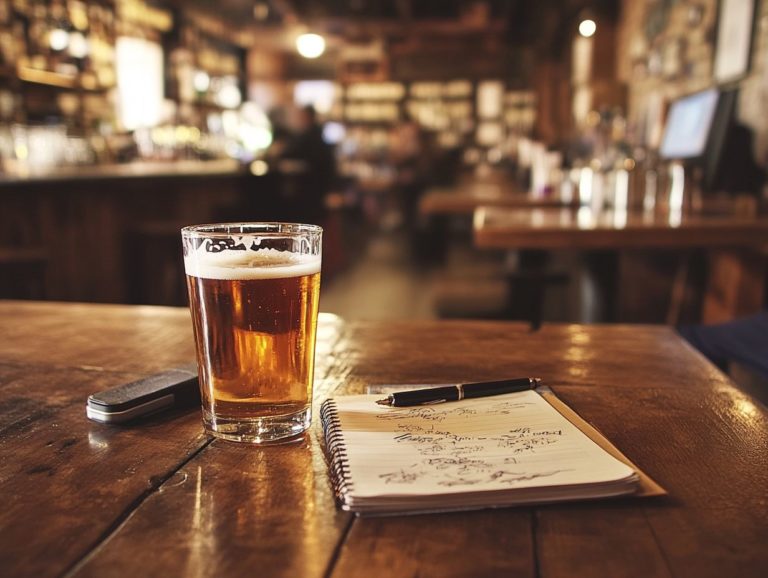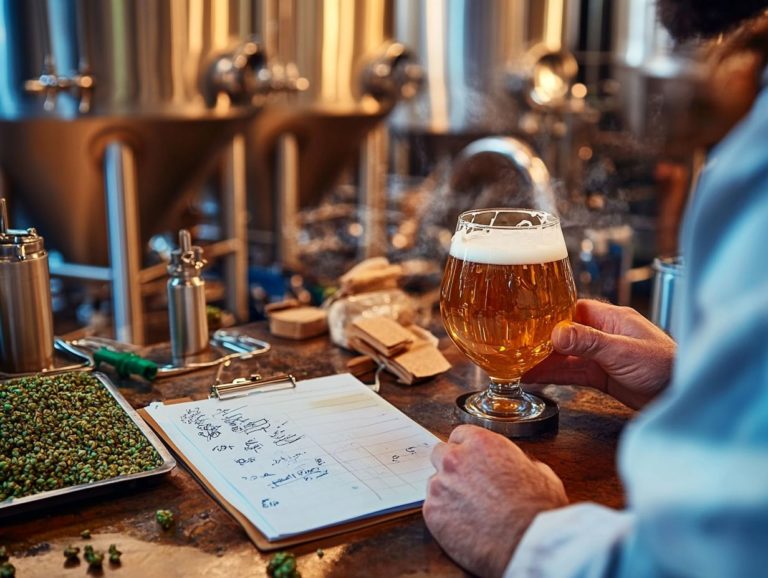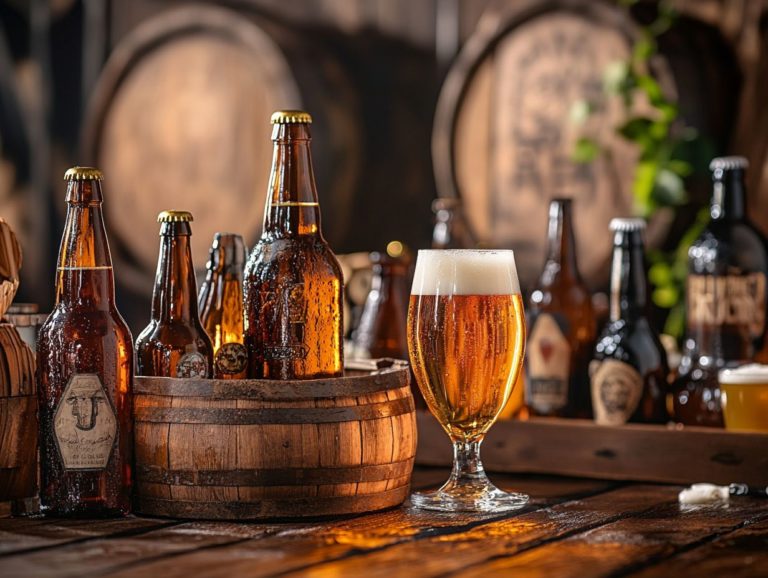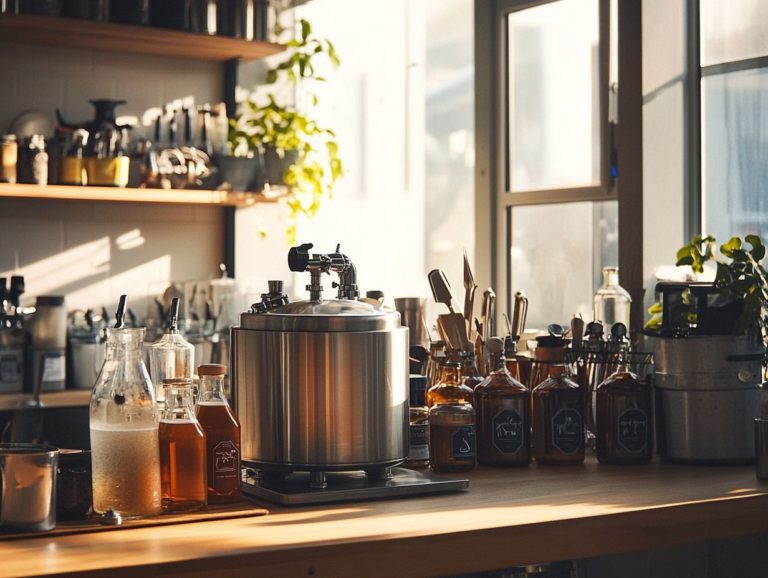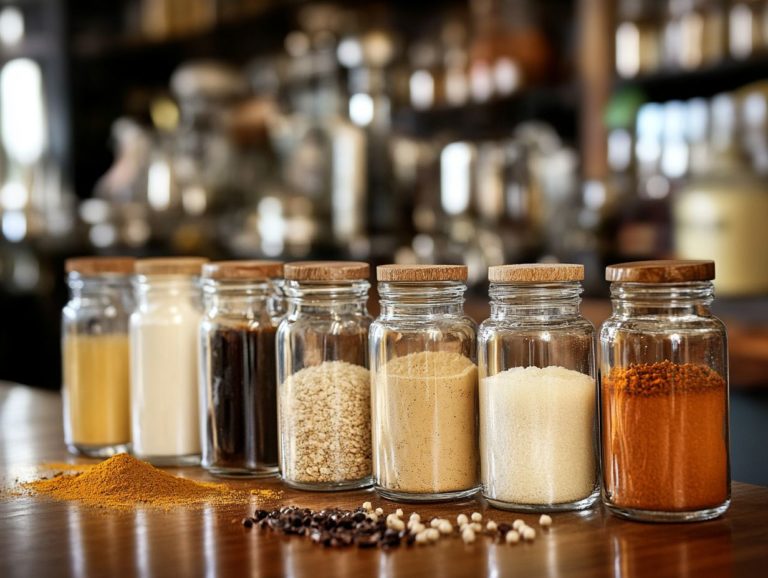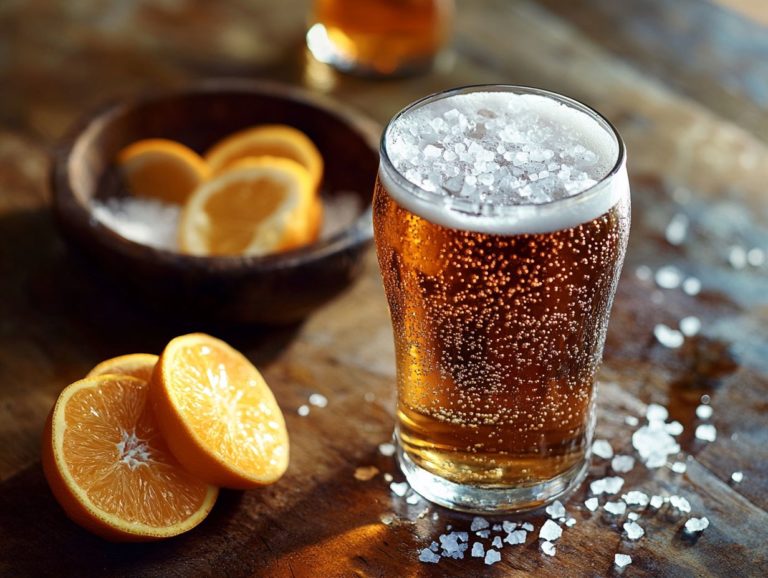How to Deal with Overly Bitter Beer
Beer lovers often debate one key element: bitterness. Whether you’re brewing at home or sipping at the bar, understanding this quality can transform your experience.
Beer enthusiasts often grapple with one of the most divisive qualities of their beloved beverage: bitterness.
Whether you’re sourcing ingredients from your local brew shop or setting up your kegerator, understanding bitterness is key.
While some revel in the hoppy kick, others may find it a bit too intense. By understanding the various factors that contribute to a beer’s bitterness like hop varieties, brewing techniques, and even water quality you can elevate your brewing experience.
This article delves into these elements, providing you with tips on identifying and adjusting bitterness, along with strategies for preventing overly bitter brews. Jump in now and learn how to craft the perfect beer balance!
From selecting the right brewing equipment to understanding carbonation, every detail matters.
Contents
- Key Takeaways:
- Why Does Beer Become Bitter?
- What Are the Factors That Affect Beer’s Bitterness?
- How to Determine if Beer is Too Bitter?
- Ways to Reduce Bitterness in Beer
- 3. Adding Acid
- 4. Diluting with Water
- What Are the Tips for Preventing Bitter Beer?
- 1. Proper Sanitation
- 2. Controlling the Temperature
- 3. Using Fresh Ingredients
- 4. Proper Storage and Serving
- Frequently Asked Questions
- What causes beer to become overly bitter?
- Can I fix an overly bitter beer?
- How can I prevent my beer from becoming overly bitter in the first place?
- Can I still enjoy an overly bitter beer?
- Is there a way to adjust the bitterness of a finished beer and achieve a better flavor balance?
- Can I use any type of hops to reduce the bitterness in my beer and what are the best brewing techniques for this?
Key Takeaways:
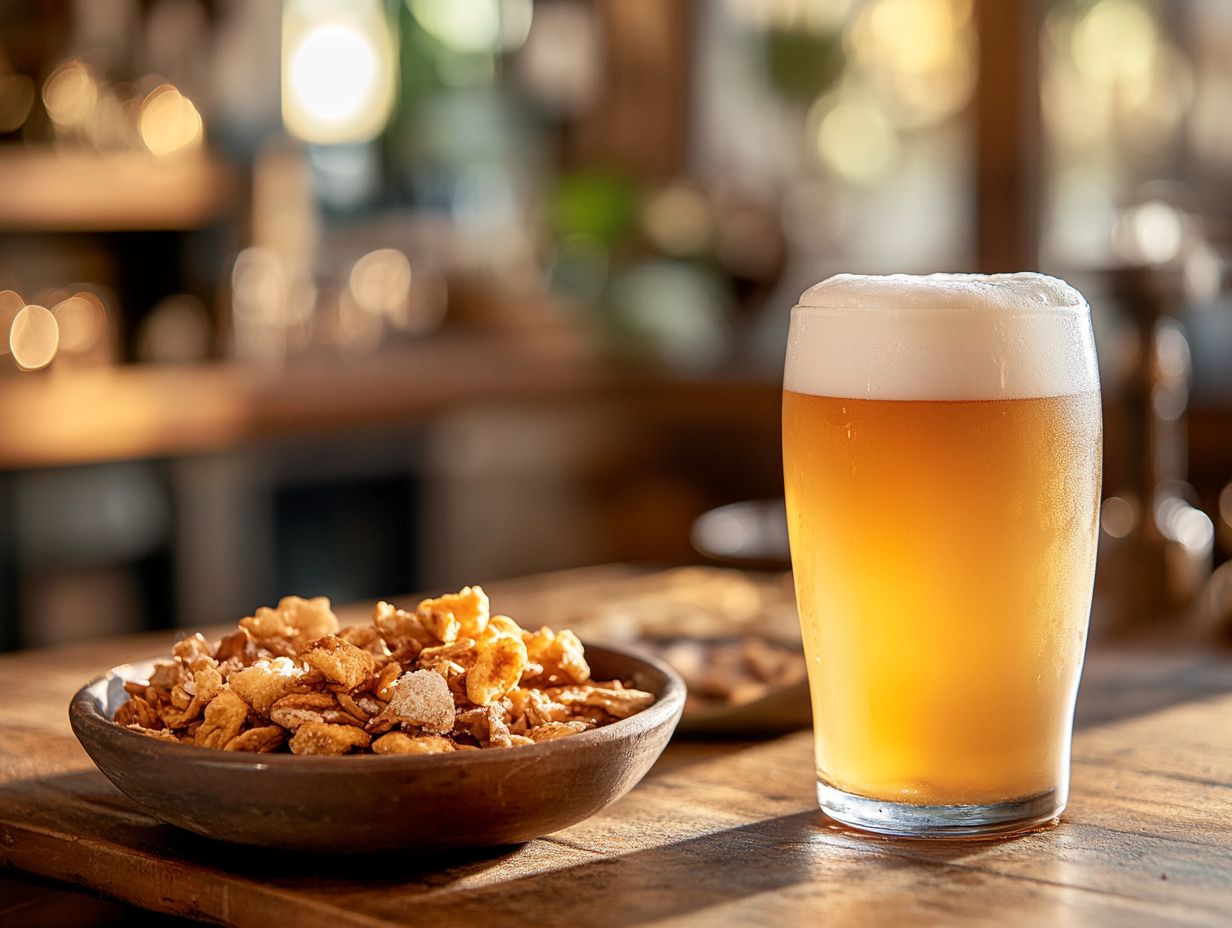
- Bitterness in beer is influenced by various factors such as hop varieties, brewing process, fermentation time, and storage conditions.
- To reduce bitterness in beer, try adjusting the hops, adding malt or sugar, or diluting with water. Using recipe kits helps you control bitterness.
- Proper sanitation, temperature control, and use of fresh ingredients can prevent beer from becoming overly bitter. Using the right fermentation vessel is also crucial.
Why Does Beer Become Bitter?
The bitterness in beer predominantly stems from the inclusion of hops in the brewing process, a key element in crafting a harmonious flavor profile. Hops, particularly varieties known for their bitterness, such as Cascade and EKG, harbor alpha acids that are unleashed during boiling, thereby enhancing the beer’s overall bitterness.
This quality is especially evident in styles like pale ale and American Amber Ale, where the role of hops is vital in shaping the beer’s flavor balance. Utilizing different brewing techniques can help you manage this bitterness effectively.
What Are the Factors That Affect Beer’s Bitterness?
Several key factors can profoundly influence the bitterness of your beer, such as the selection of hop varieties, the brewing process, fermentation techniques, and even the quality of ingredients you use during homebrewing. Proper rinsing of water is also essential to control bitterness.
By understanding these elements, you can skillfully fine-tune the bitterness levels and craft a more sophisticated flavor profile in your brews.
1. Hop Varieties
Different hop varieties each possess unique bitterness and flavor profiles that greatly shape the overall character of your beer.
Take Cascade hops, for example; they are renowned for their delightful floral and citrus notes.
The variety of hops you choose not only influences the bitterness level but also plays a pivotal role in the aroma and tasting experience of your creation.
Consider Hallertau hops; they offer a mild bitterness accompanied by subtle spice, making them a fantastic choice for lagers and pale ales. In stark contrast, Citra hops are celebrated for their bold tropical fruit flavors, delivering both intensity and a sense of perceived bitterness perfect for crafting those refreshing IPAs. Using a hop spider can make the process more manageable.
Selecting the right hops is vital for any brewer striving to achieve specific flavor profiles and bitterness levels. This thoughtful selection process ensures that the final product aligns with consumer expectations, showcasing the remarkable complexity that the world of craft beer has to offer.
2. Mastering the Brewing Process
The brewing process is essential for you to control the bitterness of your beer, particularly through the timing and quantity of hop additions during boiling and fermentation. By managing these elements with precision, you can customize the bitterness to enhance your brewing experience and achieve a harmonious balance of flavors.
Different brewing techniques can greatly influence your final product. For instance, dry hopping means adding hops after the beer has been boiled to enhance aroma without making it more bitter. The length of the boil is also crucial; longer boils often lead to a more pronounced bitter flavor profile, intensifying hop extraction.
You’ll love the flexibility all-grain brewing gives you to craft perfect bitterness levels compared to extract brewing. With all-grain, you enjoy precise control over the mash temperature and the types of grains used. This interplay of techniques and timing ultimately allows you to explore a diverse range of bitterness flavors in your final beer. Utilizing adjuncts and malt extracts can also provide additional layers of flavor.
3. Effective Storage and Ageing Techniques
The storage and aging of beer significantly influence its bitterness, as certain conditions can lead to the degradation of hop oils that impart that beloved bitter flavor. As your beer ages, you may notice the bitterness softening, ultimately transforming the beer’s characteristics and potentially lowering its perceived IBU.
Several factors come into play here, including temperature fluctuations, prolonged exposure to light, and the type of containers you choose for storage. For example, storing beer at elevated temperatures can speed up the chemical reactions that diminish hop character, while exposing your brew to UV light can lead to skunking a fate that brings off-flavors that affect how you perceive bitterness.
Beers with robust hop profiles, such as IPAs, tend to preserve their bitterness longer under the right conditions. In contrast, malty beers may reveal a more pronounced sweetness as they mature, resulting in a complex interplay of flavors that many enthusiasts find irresistible. Proper fermentation temperature control is also crucial for retaining the desired bitterness.
4. The Importance of Water Quality in Brewing
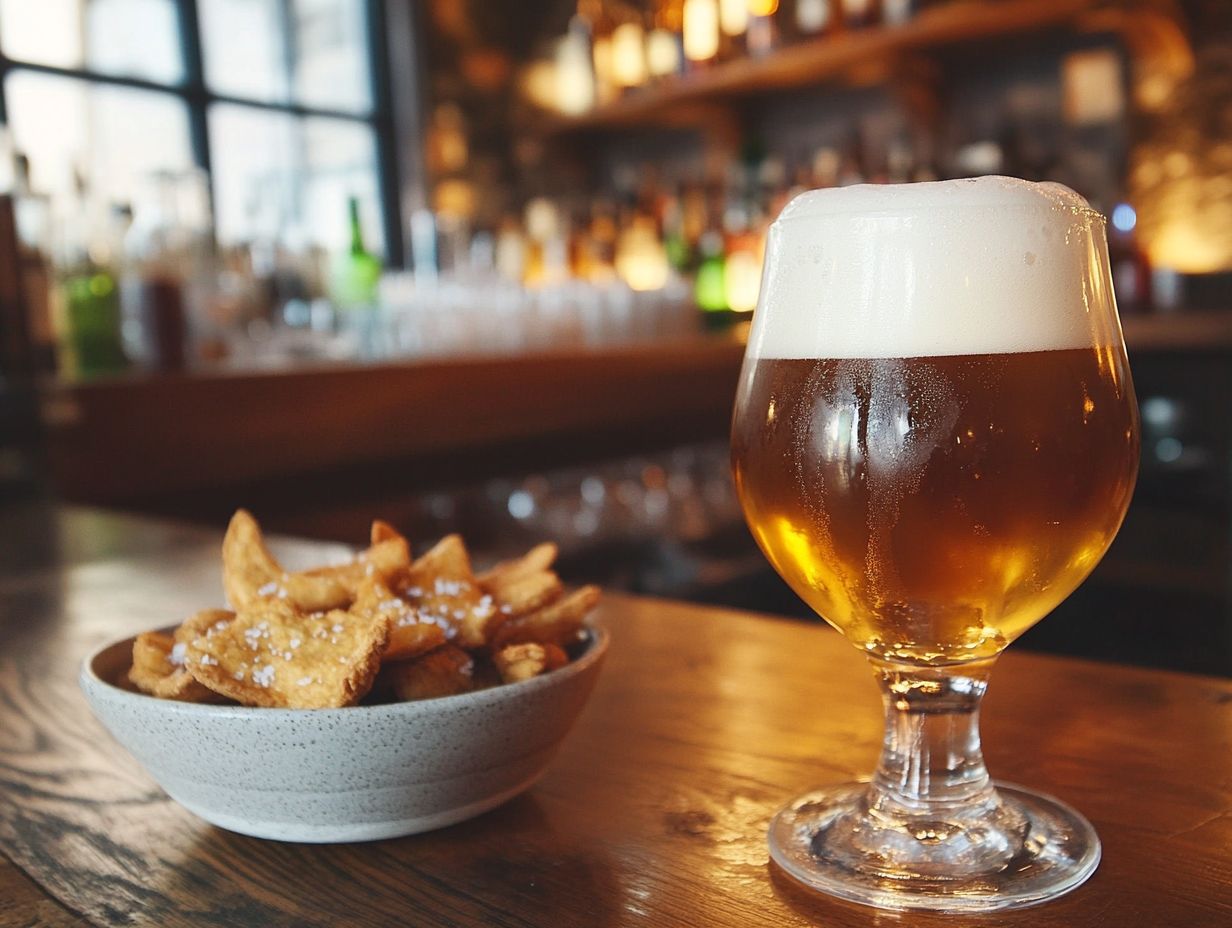
Water quality is a crucial yet often underestimated element in beer brewing, influencing not just the bitterness but also the overall flavor balance of your final masterpiece. The various minerals and pH levels in your water can significantly affect how bitterness is extracted from hops and the efficiency of your brewing process.
If your water has higher levels of calcium, it can amplify the perception of hop bitterness, while magnesium can add a delightful roundness to the flavors. If sulfates are present in excessive amounts, you might end up with a sharp bitterness that overshadows the other flavor nuances.
To customize the water profile for specific beer styles, you can fine-tune the mineral content by adding salts like gypsum or calcium carbonate. Don t forget about sparging water its quality is vital for effectively rinsing the grains and preventing any off-flavors from sneaking in.
By meticulously balancing these components, you can create a more harmonious interaction between bitterness and the inherent sweetness of your brew. The availability of different water profiles from suppliers like Tesco also plays a role in the brewing process.
How to Determine if Beer is Too Bitter?
Determining whether a beer has ventured into the realm of excessive bitterness hinges on your grasp of flavor balance and the International Bitterness Units (IBU) scale, which measures the bitterness of beer. As you taste the beer, consider how its bitterness aligns with the intended flavor profile and how its IBU rating compares to similar styles.
This balance is essential because a beer should not be defined solely by its bitterness but also enriched by the sweetness of its malt, the aroma of its hops, and any other distinctive traits it may possess. As you explore different styles, you might notice that certain varieties, such as IPAs, often embrace higher bitterness levels with IBU ratings frequently soaring above 60, while others, like cream ales or wheat beers, exhibit a more subdued bitterness.
By understanding this context, you can truly appreciate the harmonious interplay of bitterness and sweetness, transforming the tasting experience into something far more enjoyable.
Ways to Reduce Bitterness in Beer
You have several effective strategies at your disposal for reducing bitterness in beer. This is especially useful if you find that your final product has surpassed the desired flavor profile.
Consider adjusting the quantities of hops you use. This can significantly impact the overall taste. You might also enhance sweetness by adding malt or sugar, creating a more harmonious balance. Checking out brewing tips from the brewing community, like BobbiLynn or saulgood88, can also be beneficial.
Diluting the beer helps achieve a more refined flavor experience, allowing you to perfect your brew to your liking.
1. Adjusting the Hops
Want to reduce bitterness? Adjusting your hop schedule is one of the best ways to achieve that. Try lowering the amount of bittering hops or changing when you add them. This approach proves especially beneficial when you consider dry hopping, which contributes delightful aroma without significantly ramping up bitterness.
Using a hop spider can also make hop additions easier to manage. By fine-tuning these variables, you have the opportunity to craft a more balanced profile that highlights the beer’s inherent flavors instead of overwhelming it with sharp bitterness.
For instance, incorporating noble hop varieties like Saaz or Hallertau can introduce subtle floral and herbal notes, enriching the overall tasting experience.
Employing late hopping techniques where hops are added in the final moments of the boil or during fermentation allows for enhanced aroma and flavor while avoiding the harshness often associated with bitterness. Utilizing Kviek yeast can also help in maintaining a balanced hop character.
This method lets you dive into exciting new flavor dimensions while keeping the bitterness in check, a hallmark of many modern IPAs. Here, you’ll find citrusy or fruity hops like Citra or Mosaic featured prominently yet in perfect harmony, creating a truly delightful brew.
2. Adding Malt or Sugar
Incorporating additional malt or sugar into your brewing process can effectively counterbalance excessive bitterness by enhancing the sweetness of your beer. Whether you’re brewing a Pale Ale or an American Amber Ale, this approach helps you achieve a more harmonious flavor balance, allowing for a smoother taste experience that softens the perception of bitterness.
By introducing specific types of malt, such as caramel or crystal malts, you can elevate the beer s sweetness and body. For instance, caramel malts deliver rich, toasty notes that beautifully complement various hop profiles while maintaining a delightful sweetness that rounds out the overall flavor.
Consider adding Cascade hops or experimenting with dry hopping for enhanced aroma and complexity. Adding adjuncts like corn sugar or honey not only increases the fermentable sugars but also infuses unique flavors that enrich the beer’s character.
Using adjuncts like these thoughtfully enhances the flavor profiles and ensures a well-rounded experience, making your brew significantly more enjoyable for anyone fortunate enough to indulge.
3. Adding Acid
Adding acids like lactic acid or citric acid can be a highly effective strategy for reducing bitterness in your beer. By incorporating these acids, you create a contrasting flavor that brightens the overall taste without overshadowing the beer’s unique character. Using this technique wisely can improve the flavor balance, especially when fine-tuning your brew process.
When you meticulously control the levels of these acids, you can achieve a specific profile that beautifully complements the other ingredients, such as hops and malt. For example, lactic acid, whether sourced from souring agents or directly added during the brewing process, brings a gentle tartness that can elevate fruity notes. This is especially desirable in styles like Berliner Weisse or American Wheat beers.
Monitoring fermentation temperature during this process also ensures optimal flavor extraction and balance. Conversely, citric acid adds zest and a refreshing finish, making it an excellent choice for pale ales or IPAs. Striking the right balance enhances the complexity of your beer and attracts a broader audience, making it a crucial consideration in crafting unique and harmonious brews.
4. Diluting with Water
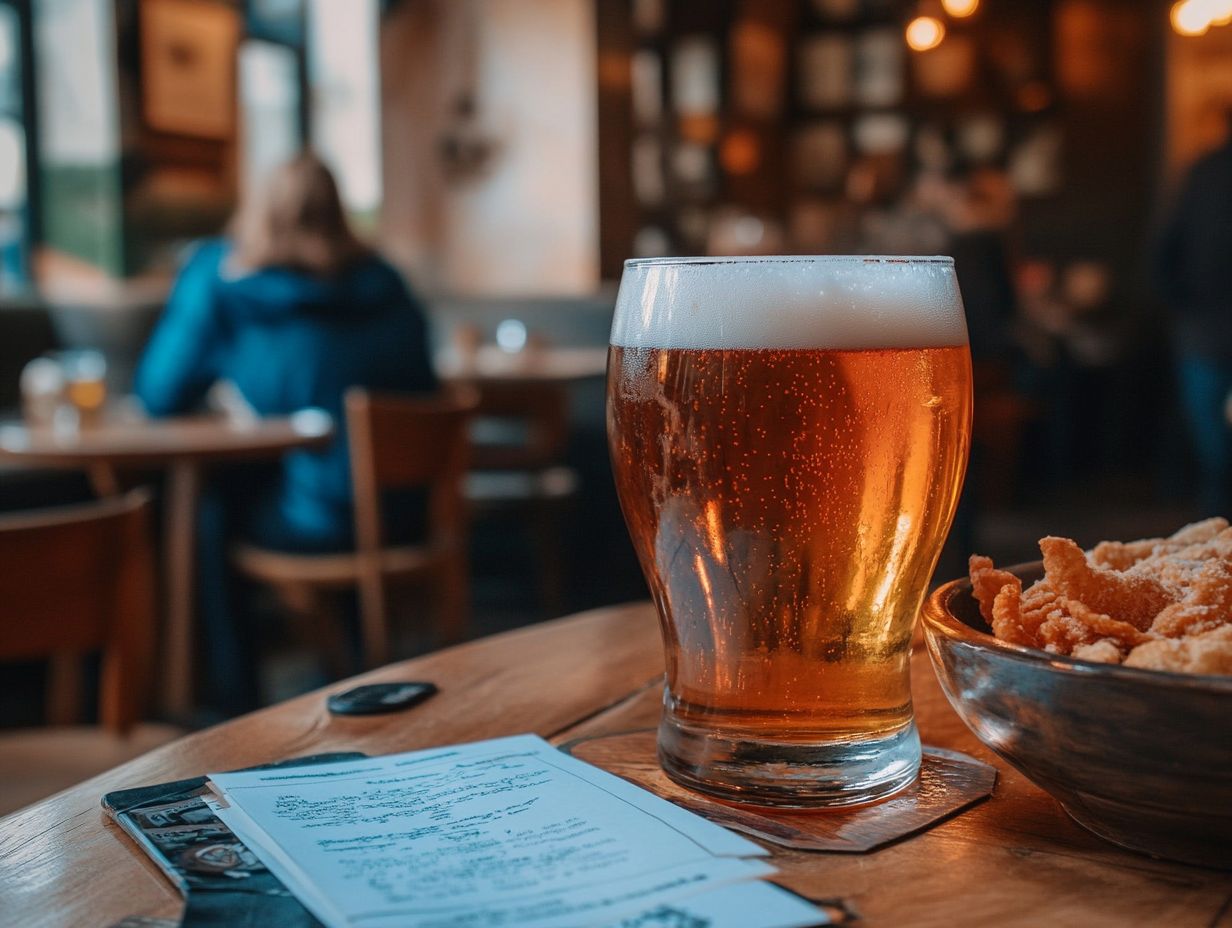
Diluting excessively bitter beer with water is a straightforward way to reduce bitterness. However, be mindful that this approach might also lessen other flavors in the mix. You want to apply this technique carefully to maintain a delightful flavor balance and ensure the overall quality of the beer remains intact. For best results, use sparge water, which is water used during rinsing the grains, that has been properly treated to avoid introducing unwanted flavors.
As you contemplate this method, it’s essential to recognize that while dialing down bitterness can make certain beers more appealing to those who prefer milder tastes, it may also strip away some complexity. Those rich notes of caramel, malt, or hops could become less pronounced, leading to a more one-dimensional experience.
Consider using a hop spider, a tool that holds hops and allows for easy removal, to refine hop additions and better control the bitterness in your homebrew. If you decide to dilute, doing so gradually gives you better control over the final taste.
A splash of water can enhance particular aromatic characteristics without overwhelming the beer, helping to prevent that flat taste that no one enjoys. Ultimately, understanding your palate and picking the right moment to dilute can turn a bitter challenge into a pleasantly mellow brew.
What Are the Tips for Preventing Bitter Beer?
To prevent bitterness in your beer, begin with meticulous attention to your brewing practices. This means prioritizing proper sanitation, utilizing fresh ingredients, and controlling fermentation temperatures with precision.
By adhering to these guidelines, you ll create a beer that delights while steering clear of excessive bitterness.
1. Proper Sanitation
Proper sanitation practices in brewing are vital for preventing off-flavors and unwanted bitterness. Contaminants can easily introduce overpowering characteristics to your beer, so using sanitized brewing equipment and fermentation vessels is crucial for achieving a clean and delightful flavor profile. This is critical whether you are brewing with all grain methods or using extract kits.
To ensure that your brewing process yields a superior product, you must pay careful attention to every step, from cleaning and rinsing your ingredients to properly sanitizing your tools both before and after use. Utilize food-grade sanitizers and adhere to the recommended contact times to maximize their effectiveness. This ensures the quality of your homebrew remains consistently high.
Every surface that comes into contact with the beer deserves meticulous cleaning and inspection to eliminate potential sources of infection or spoilage. This includes your fermentation vessel, which must be thoroughly sanitized.
This diligent approach not only protects the intended flavors and aromas of your brew but also enhances overall consistency. By doing so, you position yourself for repeatable results and a more predictable outcome in flavor and quality with each batch.
Share your brewing experiences or tips in the comments below!
2. Controlling the Temperature
Controlling fermentation temperature is essential for avoiding bitterness and achieving the flavor characteristics you desire.
Different yeast strains respond uniquely to temperature fluctuations during fermentation. By maintaining the ideal temperature, you ensure a healthy fermentation process that leads to balanced and refined flavors. This is especially important for delicate beer styles, such as NEIPA and IPA.
Take, for example, the popular ale yeast strain, Saccharomyces cerevisiae. It flourishes between 68 F and 72 F, producing fruity esters that elevate the beer’s profile. On the other hand, lager yeasts like Saccharomyces pastorianus prefer cooler conditions, around 50 F to 55 F, which results in clean and crisp profiles. Using yeast like US05 can also provide consistency in your brewing.
To effectively manage these temperatures, you might consider employing techniques such as fermentation chambers for precise control or simply wrapping your fermenters in blankets and using ice packs during the warmer months. By closely monitoring the process and making adjustments as necessary, you can nurture yeast health and unlock the full potential of each batch while minimizing any unwanted off-flavors.
3. Using Fresh Ingredients
Use fresh ingredients in your brewing process to add an unwelcome bitterness that can compromise your beer. Fresh hops and malt extracts not only elevate the flavor but also enhance the overall quality of your brew.
Visit a reputable brew shop or homebrew supply store to ensure you get the freshest ingredients. When you’re sourcing your ingredients, take a moment to consider the harvesting and processing dates, as these factors can significantly influence their freshness.
For example, opting for hops that have been properly stored and recently harvested ensures that their aromatic oils and flavor compounds are at their peak, ready to infuse your beer with vibrant character. This is particularly important when brewing hop-forward styles like IPAs.
Selecting high-quality malts from reputable suppliers who are transparent about their aging processes will further safeguard the integrity of your brew. Proper storage is equally vital; keeping your hops in a cool, dark place and sealing your malt bags tightly protects them from moisture and light exposure, preserving their vibrancy and preventing spoilage.
These steps are key to achieving the flavor profile you desire and ensuring a successful brewing outcome that you can be proud of.
4. Proper Storage and Serving
Proper storage and serving of beer are crucial for maintaining its intended flavor profiles and preventing bitterness from creeping in over time. By ensuring that you store beer at consistent temperatures and serve it in the right glassware, you can significantly enhance your drinking experience.
Consider investing in a kegerator (a refrigerator designed to store and serve draft beer) for optimal draft beer storage and serving conditions at home. Temperature control is vital for preserving the delicate balance of flavors in each brew.
For optimal enjoyment, lagers should be stored at cooler temperatures, typically around 45-55 F, while ales thrive in slightly warmer conditions.
Minimizing light exposure is equally important; ultraviolet rays can introduce skunky flavors that can compromise a beer’s complexity. Choosing the right glassware elevates the presentation and optimizes aroma release, allowing you to fully appreciate the intricate nuances of bitterness and flavor.
Ultimately, adhering to these best practices ensures that every sip you take delivers the intended enjoyment without any unwanted alterations.
Frequently Asked Questions
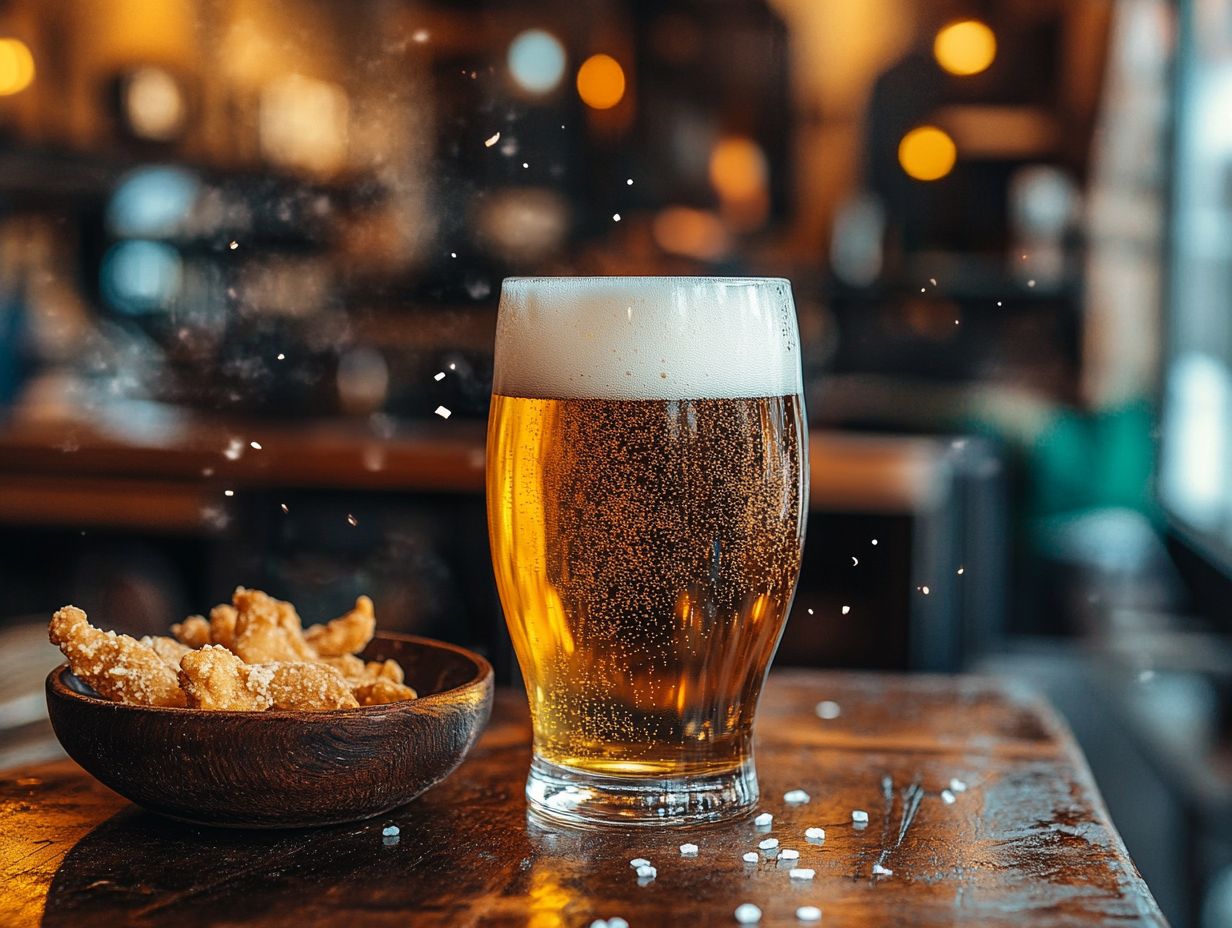
What causes beer to become overly bitter?
There are a few factors that can contribute to overly bitter beer, including using too much bittering hops during the brewing process, leaving the hops in the beer for too long, or using a type of hops that is known for its high bitterness. Additionally, not controlling fermentation time properly can also affect the balance of flavors.
Can I fix an overly bitter beer?
Yes, there are a few ways to try to reduce the bitterness in your beer. You can blend it with a less bitter beer, add a small amount of sugar or honey to balance the bitterness, or dilute it with unfermented wort or water.
Adjusting your hop additions during the brewing process can also help manage bitterness.
How can I prevent my beer from becoming overly bitter in the first place?
To prevent overly bitter beer, carefully measure and add hops during the brewing process. Remove them from the beer at the appropriate time.
You can use less bittering hops or different hop varieties with lower bitterness levels. For more tips, consult brewing forums and brewing community resources for additional brewing tips and advice on achieving the desired hop profile.
Can I still enjoy an overly bitter beer?
Everyone’s palate is different, so what may be overly bitter for one person could be enjoyable for another. If you find a beer too bitter for your taste, try pairing it with food or mixing it with other ingredients to create a balanced flavor profile.
For instance, pairing a bitter beer like a Pale Ale with the right dish can elevate your overall flavor experience. Don’t miss out!
Is there a way to adjust the bitterness of a finished beer and achieve a better flavor balance?
If your beer is too bitter, try adding a small amount of salt. You can also use acid, like lemon or lime juice, to help balance the flavors. Be careful not to add too much, as it may affect the overall flavor of the beer.
Experimenting with different adjuncts and malt extracts can help achieve a better flavor balance in your beer.
Can I use any type of hops to reduce the bitterness in my beer and what are the best brewing techniques for this?
Some brewers have successfully reduced bitterness by adding hops after fermentation, using certain types of hops, such as noble or floral hops, known for their lower bitterness levels.
However, results may vary. It’s best to research and experiment with different hop varieties and additions to find the best solution for your specific beer. Consulting with your local brew shop or homebrew supply can provide insights into best practices for managing bitterness.

